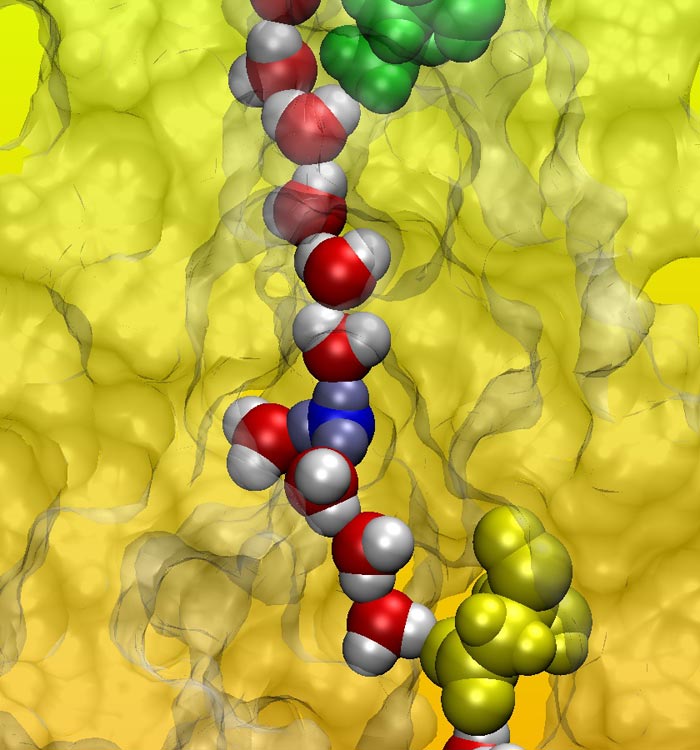Mechanism of biological multi-fuel engine

Proton permeation through flagellar motor stator complex MotA/B. Based on the model of the three-dimensional structure of MotA/B identified in this research, protons can permeate through the gate (green) of the motor by diffusion of hydronium ions (blue), which induces the formation of a water wire (red and white) that may mediate the proton transfer to the proton binding site (yellow). © 2015 Yasutaka Nishihara and Akio Kitao.
University of Tokyo researchers have constructed the atomic model structure of the protein complex that corresponds to the stator (stationary part of a motor that surrounds the rotating part of a motor) of the E. coli flagellar motor for the first time by molecular simulation based on previously published experimental data, and elucidated the mechanism by which ions, including hydrogen ions (protons), are transferred through the stator.
Bacteria such as E. coli and Salmonella swim by rotating flagellar motors and filaments, which highly efficiently utilize the energy originating from the difference in ion concentration between the cell interior and exterior.
Among the bacterial flagellar motors, some convert the energy by the permeation of protons through the motor stator, while others utilize sodium ions or multiple ions. However, the atomic structure of the bacterial flagellar motor remained unknown, and the mechanism of ion permeation had not been elucidated in detail.
Project Researcher Nishihara Yasutaka at the Graduate School of Arts and Sciences and Associate Professor Akio Kitao at the Institute of Molecular and Cellular Biosciences constructed a three-dimensional model structure of the protein complex that comprises the flagellar motor stator MotA/B, and found that protons permeate through the transmembrane stator as hydronium ions, inducing a motion similar to a ratchet wrench (ratchet movement) limited to one directional rotation.
Investigation of this type of highly efficient energy conversion mechanism is essential to understand biological mechanisms which can utilize energy efficiently.
Paper
Nishihara Yasutaka and Akio Kitao, “Gate-controlled proton diffusion and protonation-induced ratchet motion in the stator of the bacterial flagellar motor”, Proceedings of the National Academy of Science of the United States of America Online Edition: 2015/6/9 (Japan time), doi: 10.1073/pnas.1502991112.
Associated links
U Tokyo Research article
Media Contact
More Information:
http://www.researchsea.comAll latest news from the category: Life Sciences and Chemistry
Articles and reports from the Life Sciences and chemistry area deal with applied and basic research into modern biology, chemistry and human medicine.
Valuable information can be found on a range of life sciences fields including bacteriology, biochemistry, bionics, bioinformatics, biophysics, biotechnology, genetics, geobotany, human biology, marine biology, microbiology, molecular biology, cellular biology, zoology, bioinorganic chemistry, microchemistry and environmental chemistry.
Newest articles

Machine learning algorithm reveals long-theorized glass phase in crystal
Scientists have found evidence of an elusive, glassy phase of matter that emerges when a crystal’s perfect internal pattern is disrupted. X-ray technology and machine learning converge to shed light…

Mapping plant functional diversity from space
HKU ecologists revolutionize ecosystem monitoring with novel field-satellite integration. An international team of researchers, led by Professor Jin WU from the School of Biological Sciences at The University of Hong…

Inverters with constant full load capability
…enable an increase in the performance of electric drives. Overheating components significantly limit the performance of drivetrains in electric vehicles. Inverters in particular are subject to a high thermal load,…





















